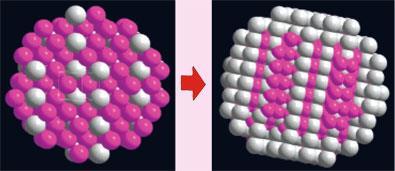Mixed metal nanoparticles could boost fuel cell catalyst activity sixfold
Alloy nanoparticles that efficiently catalyse oxygen’s conversion into water - the energy-releasing reaction that occurs in fuel cells - have been discovered by Peter Strasser and colleagues at the University of Houston, US. The particles are up to six times more active than pure platinum, the material typically used in current fuel cells.
Strasser initially examined particles combining platinum and copper, which were subjected to an electrochemical dealloying process to remove copper from the particle surface.1 The resulting catalyst has a platinum-rich outer shell - where the reaction takes place - combined with a copper-enriched core.
’We were investigating different catalyst stoichiometries, and noticed alloys with over 50 per cent copper had high activity,’ Strasser told Chemistry World. ’We were sure these catalysts couldn’t be stable - that the copper had to be leaching away during the electrochemical reaction. But leaching away the surface copper is exactly what gives you the high activity, so we turned this into a synthetic strategy.’
Simply making an alloy of 80 per cent platinum and 20 per cent copper gives a catalyst little better than pure platinum, said Strasser. But making an alloy of the same proportions by dealloying a copper-rich precursor produces a much more active catalyst. ’The corrosion process activates the catalyst, because there’s some base metal in the core, but a platinum-rich shell.’
Elevated Activity
Strasser attributes the enhanced reactivity to slightly shorter distances between neighbouring platinum atoms in the particle shell, a geometric difference that stems from the copper atoms in the core.2 ’Shorter platinum-platinum distances change the metal’s electronic structure, which changes the strength of the bond that forms between platinum and oxygen [during catalysis]. And we know catalytic activity is all about bond strength.’
’We plan to corroborate, or correct, the hypothesis by collaboration with the Stanford Cyclotron to see if the platinum-platinum distance really is smaller,’ Strasser added. ’Also, the durability of our catalysts is unclear, and requires more work to understand how stable it would be over the lifetime of a fuel cell.’

The Houston team has also extended the technique to ternary mixtures that include cobalt as well as platinum and copper, which similarly were four to five times more active than pure platinum.
But Frank DiSalvo, who works on nanoparticular electrocatalysts at the Cornell Fuel Cell Institute, US, told Chemistry World that catalysts with 10-100 times better activity are needed.
’A third of the fuel cell’s energy is currently lost driving this reaction,’ he said. ’To make a big advance you really need an electrode more like two to three orders of magnitude more active.’
James Mitchell Crow
Enjoy this story? Spread the word using the ’tools’ menu on the left.
References
R Srivastava et al., Angew. Chem. Int. Ed., 2007 (DOI: 10.1002/anie.200703331)






No comments yet